How Many Moons Does Uranus Have? (Facts, & FAQ)
Last Updated on
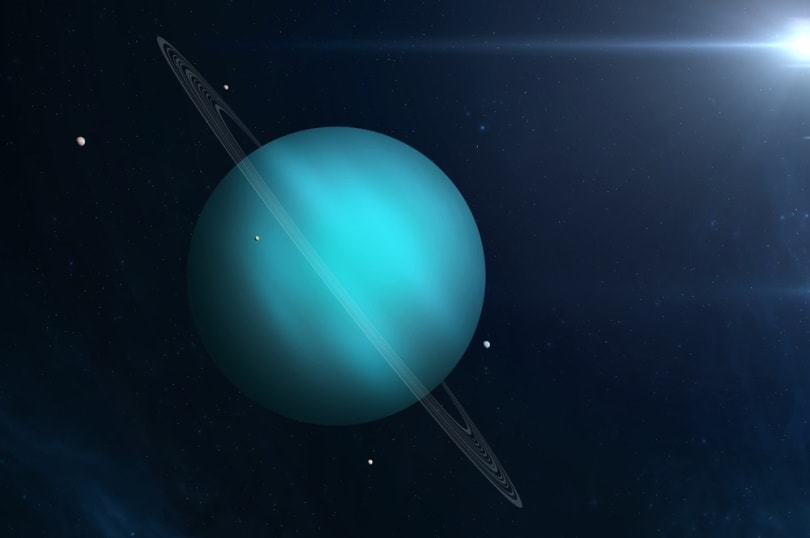
Our solar system consists of several ice and gas giants that are breathtaking to look at and equally interesting to learn about. One would instantly think of Jupiter when it comes to the number of moons a planet has. After all, the gas giant consists of around 79 moons! But how many moons does Uranus have?
Until now, astronomers have identified about 27 moons around Uranus, termed “Uranian.” Out of these, five are large, and 22 are small. The large moons include Ariel, Miranda, Umbriel, Oberon, and Titania. While Titania is the largest moon of Uranus, Ariel is known as the brightest moon for the planet.
Like other planets, it required the efforts of several astronomers to discover the moons of Uranus. If you want to know more about the history of these moons, this article will give you deeper insights into Uranian moons. So, let’s get started!

The Discovery and Naming of the Moons
The discovery of Uranian moons started in the 18th century when astronomer William Herschel identified Oberon and Titania. It was on the 11th of January 1787, almost 6 years after, when Uranus was discovered.
Herschel claimed that he observed around six satellites and a ring. However, the discovery of the rings was discredited later.
More Discoveries
For 50 years, the instrument through which Herschel saw the moons remained the only tool to observe the two moons. Fast forward to the 1840s, the invention of advanced devices helped astronomers view Oberon and Titania yet again. This also led to the discovery of two additional moons, Ariel and Umbriel, by William Lassell in 1851.
Lassell then numbered these early-discovered moons as I through IV from Uranus outward. Finally, in 1852, John Herschel, the son of William Herschel, gave these four moons their current names. He took inspiration from The Rape of the Lock by Alexandar Pope and A Midsummer Night’s Dream by William Shakespeare. Ariel and Umbriel got their names after Pope’s characters, and Titania and Oberon’s names were inspired by the queen and king of the fairies.
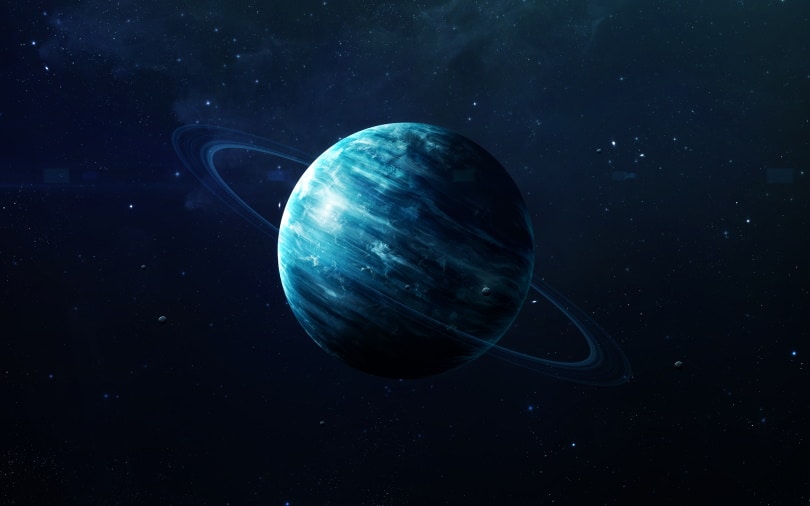
Around a century later, Gerard Kuiper discovered Miranda, the smallest of Uranus’s five large moons. Like the previous four moons, Miranda was also named after one of Pope’s characters. After multiple decades, in January 1986, the Voyager 2 space probe’s flyby discovered 10 more moons. Similarly, Perdita was found in 1999 when astronomers were studying old Voyager images.
Since 1997, astronomers have identified nine distant and irregular moons with ground-based telescopes. In 2003, the use of the Hubble Space Telescope led to the discovery of two small inner moons named Cupid and Mab. The latest Uranian moon, Margaret, was discovered in 2012.
Large Moons of Uranus
The largest moons of Uranus, Miranda, Ariel, Oberon, Titania, and Umbriel, are particularly dark with low geometric albedos and bonds. While Ariel is the brightest, Umbriel is the darkest. These moons are considered to be developed in the accretion disc orbiting around Uranus after its formation. Some people also believe that they resulted from the immense impact that Uranus suffered in early history.
The largest moons of Uranus come with no discernible atmosphere. In addition, they experience extreme seasonal cycles due to their orbit around Uranus.
These moons orbit around the equatorial plane of Uranus, while the planet orbits around the Sun from its side. As a result, Uranus’ northern and southern hemispheres face prolonged mornings and nights, around 42 years at a time.
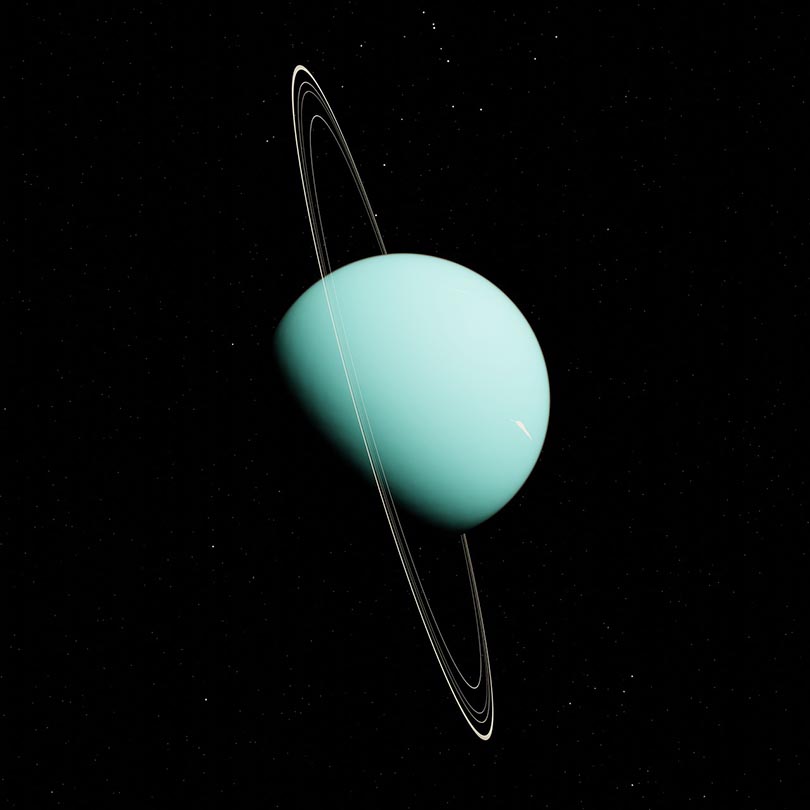
Titania
Titania is the largest moon of Uranus and the eighth-largest moon in the entire solar system, measuring 980 miles in diameter. It measures less than half of the size of Earth’s moon. It is 271,104 miles away from Uranus, so it takes 8.7 Earth days to complete one orbit around the planet.
Since Uranus orbits on its side, the moons orbiting around the planet are moving vertically. In contrast, Earth’s moon moves horizontally.
Miranda
Miranda is an interesting Uranian moon with an average diameter of 293 miles. It is located 80,176 miles from Uranus, taking the moon 1.413 Earth days to complete one orbit around the planet.
The exciting part about Miranda is that its fault canyons can get 10 times deeper, like the Grand Canyon. It’s still not confirmed why Miranda has such a rigid surface. However, some scientists believe that it is because of the partially melted ice that comes to the surface when objects crash into the moon.
According to this theory, the Sun may play a significant role in melting the ice since each pole of the planet stays in straight sunlight for 42 years.
Ariel
Being the brightest moon of Uranus, Ariel has an average diameter of 719.4 miles. It is 118,620 miles away from Uranus, taking around 2.52 Earth days to complete one orbit around the planet.
It is composed of 50% rock and 50% ice. The moon has long canyons throughout its surface, differentiating it from other Uranian moons.
Scientists are still not sure about these canyons, but most don’t consider water a primary reason behind them. That’s because water formation is almost impossible at such temperatures.
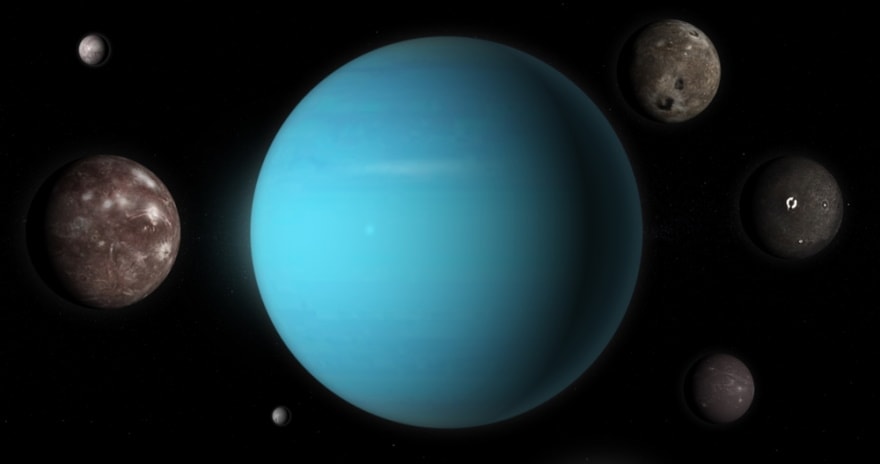
Umbriel
Umbriel has a bright ring spot on its surface that looks like a fluorescent cheerio. Its average diameter measures around 727 miles. Umbriel is located 165,285 miles away from Uranus, taking around 4.144 Earth days to complete one orbit around the planet.
One theory behind Umbriel’s ring spot is that it is influenced by a large object that brought the brighter inner material of the moon to the surface. However, nothing has been confirmed yet.
Inner Moons of Uranus
According to the latest statistics, Uranus possesses 13 inner moons. As per the correct order of their distances from Uranus, these are Cordelia, Ophelia, Bianca, Cressida, Desdemona, Juliet, Portia, Rosalind, Cupid, Belinda, Perdita, Puck, and Mab. All these names are inspired by the characters in Shakespeare’s plays.
Every inner moon is connected to the ring system of Uranus, which is believed to form from the pieces of one or multiple small inner moons. The largest inner moon of Uranus is Puck. It was the only inner moon that Voyager 2 observed in detail. Mab and Puck also serve as the two outermost inner satellites of Uranus.
Uranus’ inner moons are made of water ice mixed with a dark material (most probably the organic materials that result from the planet’s radiation). So, these moons are dark objects. The system is also unstable, as some scientists believe that some inner moons (Desdemona and Cressida) may collide in the next 100 million years.
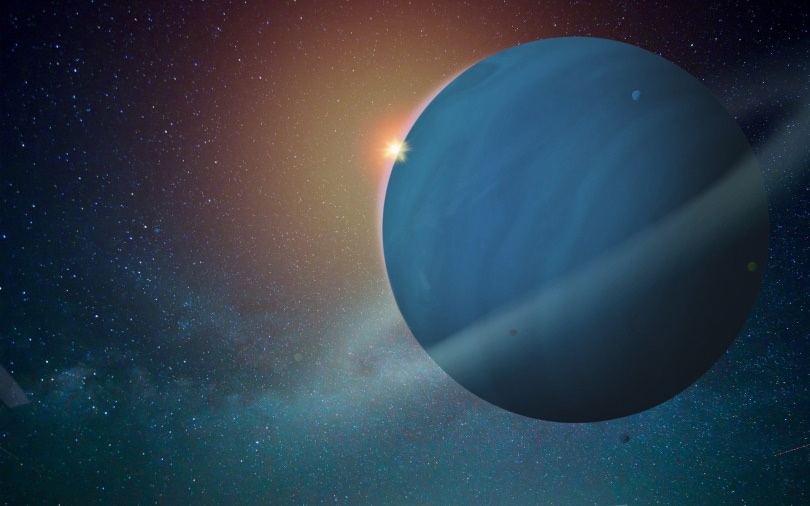
Irregular Moons of Uranus
Uranus also has nine irregular moons, orbiting the planet at even greater distances than Oberon. These irregular moons are expected to be objects that Uranus captured after its formation.
According to their distance from Uranus, the correct order is Francisco, Caliban, Stephano, Trinculo, Sycorax, Margaret, Prospero, Setebos, and Ferdinard. All of them are named after the characters of Shakespearean plays.
These irregular moons, or “captured objects,” range significantly in size. Except for Margaret, these moons circle around Uranus in retrograde orbits, which means they orbit in the opposite direction of where Uranus spins.
Like the inner moons, Uranian irregular moons are also unstable. For instance, scientists believe that some irregulars may collide with the inner moons in 10 million or 1 billion years.

The Bottom Line
Uranus is indeed a gas giant that can hold up to 27 moons inside it. Out of these, 5 moons are the largest, 13 are inner moons, and 9 are irregular moons. All Uranian moons are named after the characters of William Shakespeare’s and Alexander Pope’s plays. William Herschel discovered the planet.
Today, what we know about Uranus’ moons is because of the Voyager 2 space probe, which is the only spacecraft that captured up-close photos of the Uranian satellites. Nevertheless, the interesting facts we know about Uranus are enough to keep scientists and astronomy lovers interested in the planet.
Featured Image Credit: buradaki, Shutterstock
About the Author Jeff Weishaupt
Jeff is a tech professional by day, writer, and amateur photographer by night. He's had the privilege of leading software teams for startups to the Fortune 100 over the past two decades. He currently works in the data privacy space. Jeff's amateur photography interests started in 2008 when he got his first DSLR camera, the Canon Rebel. Since then, he's taken tens of thousands of photos. His favorite handheld camera these days is his Google Pixel 6 XL. He loves taking photos of nature and his kids. In 2016, he bought his first drone, the Mavic Pro. Taking photos from the air is an amazing perspective, and he loves to take his drone while traveling.
Related Articles:
15 Crucial Facts About Ultraviolet Rays & the Sun
What Constellation Is Spica In? The Interesting Answer!
10 Interesting Leo Constellation Facts, Myths, and FAQs
15 Interesting Pegasus Constellation Facts, Myths, and FAQs
6 Interesting Sagittarius Constellation Facts, Myths, and FAQs in 2024!
What Are Constellations? Where Did They Come From?
8 Interesting Libra Constellation Facts, Myths, and FAQs
What Is Infrared Radiation? Science-Based Facts & FAQ
